
© Dave Morgan. (Click image for larger version)
Mariinsky Ballet
Apollo, A Midsummer Night’s Dream
London, Royal Opera House
8 August 2014
www.mariinsky.ru/en
www.roh.org.uk
Gallery of pictures by Dave Morgan
After the powerful masterpieces of two of their time-honoured Russian classics – Romeo and Juliet and Swan Lake – the Mariinsky Ballet paid homage to one of its former dancers who went on to make his mark in America – the great George Balanchine. This year would have been the 110th anniversary of his birth, and the St Petersburg company celebrated this on its London tour with three performances of ‘The Genius of Balanchine’, which includedthe Mariinsky’s UK premiere of A Midsummer Night’s Dream staged for the Russian company in 2012. The ballet is normally seen on its own in most theatres. However in London, flitting fairies with light-catching wings from an Elizabethan allegory were matched up with brilliant white-clad gods from Ancient Greece.
The ever-popular and contrasting one-act ballet Apollo was created to Igor Stravinsky’s definitive score for Diaghilev’s Ballets Russes in 1928. The impact that its simplicity and starkness must have had on those first audiences used to seeing brilliantly-coloured costumes and sets and whirling dancing can still be felt in the theatre today. The stage is bare except for a staircase structure and a stool for Apollo to sit on. The unadorned pristine white tunics for the Muses and the sun-god’s gleaming white tights and draped cloth across his bare chest leave no hiding place for anything but perfect dancing. And we got that with Vladimir Shklyarov in the title role. He is a model Apollo with the body and boyish looks to convince, and with dancing that is commanding, precise and meticulous. He leaps high, showing his strength and, with bright penetrating eyes and often amused smile, takes great interest in the Muses and the actions of the two handmaidens (here called Dancers) as they unswaddle him at his birth.
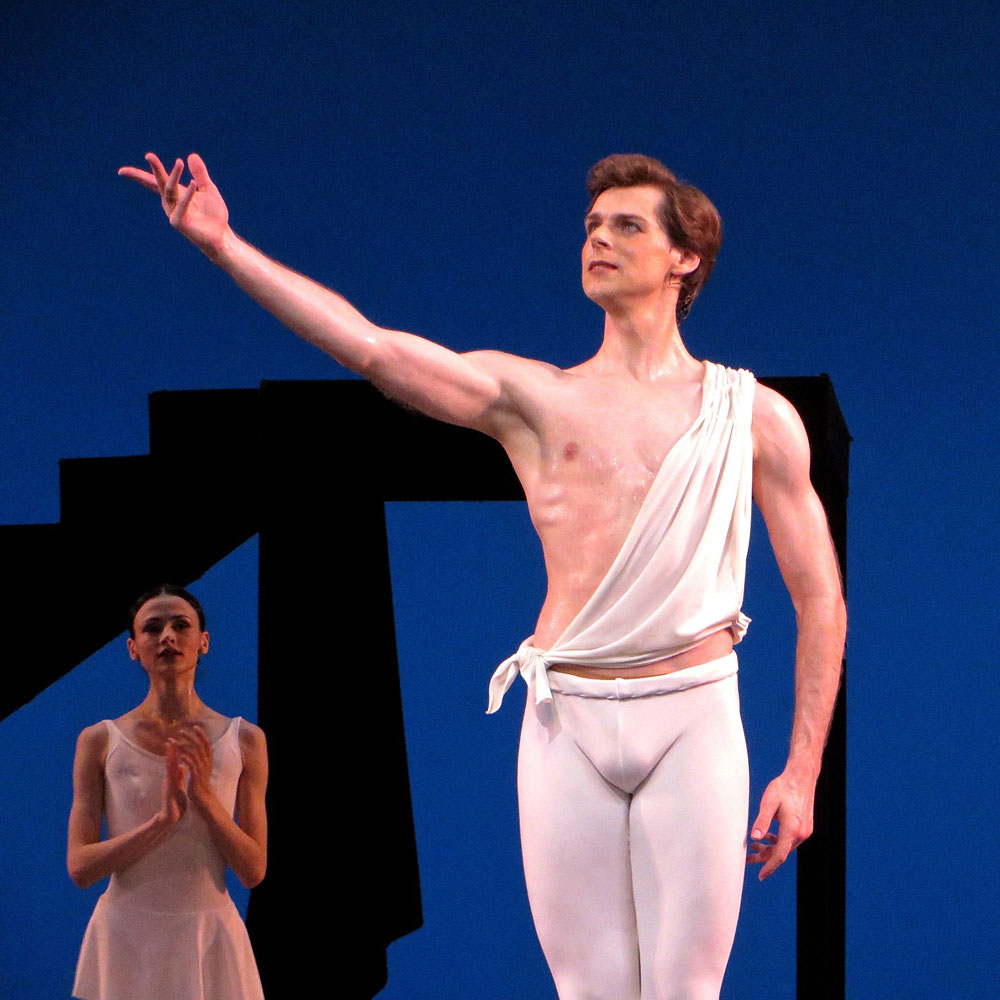
© Leena Hassan (@leenahassan). (Click image for larger version)
Shklyarov’s Apollo has a shining presence and he makes a believable god. His Terpsichore was Kristina Shapran who only joined the Mariinsky Ballet in July. (A graduate of the Vaganova School, she first joined the Stanislavsky Ballet in Moscow and was seen in London with Sergei Polunin in Coppelia last summer. She joined the Mikhailovsky Ballet in January 2014 as principal dancer, but left that company in July.) Shapran has a lithe slim figure with eloquent features, and she danced with accuracy and grace, showing off the beauty and line of the choreography. She also showed the right amount of playfulness in her ‘games’ with Apollo before her ‘swimming’ lesson, perched unaided on his back. Her beautiful legs rise effortlessly in extended arabesques and her upper body is lyrical with elegant port de bras. We shall certainly be hearing a lot more about this young ballerina.
The other two Muses also danced well. Viktoria Krasnokutskaya was Calliope, the Muse of poetry; while Nadezhda Batoeva was Polyhymnia, Muse of mime. They are individually pleasing to the eye, with neat footwork and strong technique, and as the trio followed their youthful god up to the summit of the brilliantly-lit Mount Olympus one breathed a sigh of great satisfaction at having seen the work done so well.
For many British ballet goers, including me, Balanchine’s version of the Shakespearean play was new, so there were obvious comparisons to Frederick Ashton’s exquisite distilled one-act version, which fits the Mendelssohn score so perfectly. However, Balanchine’s production, created in 1962 for New York City Ballet – two years before Ashton’s – fills two acts, padded with additional Mendelssohn music, and it was great fun, offering some wonderful dancing.
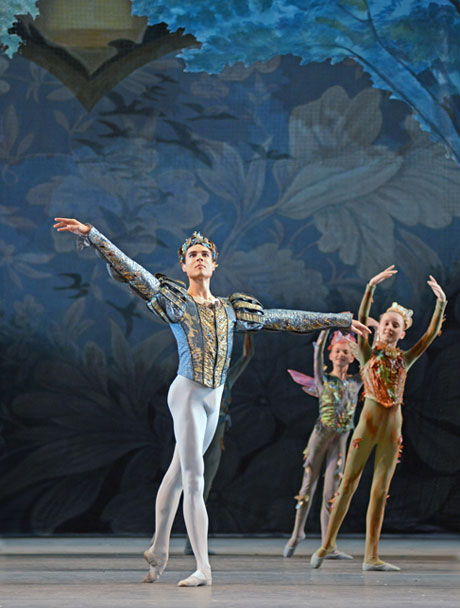
© Dave Morgan. (Click image for larger version with more helpers)
The Orchestra of the Mariinsky Ballet under the baton of Gavriel Heine played the overture with great feeling and atmosphere – especially in the lightness of the string section – and set the tone for the ballet. On a darkened stage a veritable flock of pint-sized pixies whizzed around the stage flapping their arms in make-believe flying. The quantity – over two dozen of them – and the quality of their dancing was surprisingly pleasing, and each child danced with the determination of doing one’s best and the awe of being on stage with Mariinsky Ballet dancers. It had been Hilary Condron’s job to audition and prepare these youngsters who came from The Royal Ballet School Junior Associates, the Sue Robinson School of Ballet and the Natalia Kremen School of Ballet, and in two weeks she worked wonders in getting uniform dancing and fleetness of foot.
Also fleet of foot was Vasily Tkachenko as the mischievous Puck who showed off snappy, fully-extended, speedy jetes, and engaged the audience in his misdeeds. Wearing a Peter Pan green leotard decorated with flowers and vines, his arms ‘tattooed’ with patterning, and sporting two tiny horns in his curly locks, he sped on and off stage at break-neck speed causing havoc wherever he went.
The confrontation between Oberon and Titania looked splendid, both posing in their long gossamer trains with their individual cohorts of fairies – one trying to take the Changeling Child, the other protecting him. Back in her glade Titania performed a languid and beautiful pas de deux with her Cavalier, (Kamil Yangurazov, who, while showing off his taut, high, neat beaten feet, unfortunately looked and was dressed exactly like Oberon, causing confusion to many new audience members.)

© Dave Morgan. (Click image for larger version)
Viktoria Tereshkina has a warm personality and this enhances her dancing. She has long thin limbs and offers expansive port de bras, while her legs whip up effortlessly but with control. Here, in the role of Titania, her dancing was light and lyrical, her back supple and graceful so that her movement seemed liquid with its ease and fluidity. She demonstrates much joy in her dancing and is a pleasure to watch. Timur Askerov is another lovely young dancer. He has great ease in his steps, jumping freely without effort and showing beautifully pointed feet. He made a noble Oberon, smiling and enjoying the high jinks in the forest, despite his frustration with Puck and his misdemeanours, putting out at one point his foot to trip him.
Balanchine has included two other of Shakespeare’s characters – Theseus, Duke of Athens and his bride to be, Hippolyta, Queen of the Amazons who comes complete with a pack of white hounds with waggly tails. Here, the petite and pretty Anastasia Matvienko powerfully jete-ed across the stage with speed and confidence, returning to perform on-the-spot snappy fouettes and flashing turns. She certainly showed who would be boss in her forthcoming marriage!

© Dave Morgan. (Click image for larger version)
The ‘humans’ in Shakespeare’s convoluted love quartet played their parts well with well-timed comedy and with great conviction. Krasnokutskaya was a loving Hermia with her Lysander (Andrei Yermakov). But Helena (Viktoria Brilyova,) who loves Demetrius, (danced by Xander Parish with boldness and good characterization) is rejected as he alas loves Hermia. With Puck’s bungling mischief, the situation becomes more and more humorously entangled with good reactions and expressive dancing from all four dancers.
Humour was also well milked in Bottom’s donkey transformation scene with the creature wanting to eat grass, in its reluctant trotting after a dominating Puck and its various expressions. But here Ashton wins hands down by putting his donkey on pointe. At the end of the act the story reaches its expected conclusion: Oberon and Titania make up, the four lovers get their rightful partners, and the Duke invites the two couples to celebrate their nuptials with him.
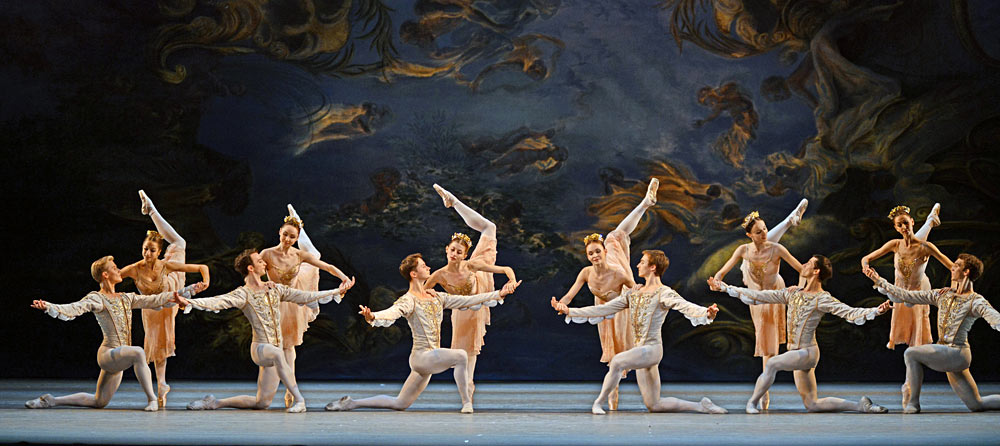
© Dave Morgan. (Click image for larger version)
Act 2 is purely classical – a sparkling divertissement à la Balanchine to Mendelssohn’s String Symphony No.9 in C major, which shimmers with beautiful movement. The leading couple for this performance was Oxana Skorik and Konstantin Zverev. She has clarity and exuberance in her dancing, and her pliable back and open épaulement give her grace and refinement. Zverev possesses a noble demeanour and was a careful partner, setting Skorik gently on pointe in the many lifts, and demonstrating elegant beats and leaps.
This Dream ends with all folk – fairy and human – reunited and happy. Peace returns to the darkening forest as the fairies settle and fireflies twinkle with light as the music quietly ties up the proceedings. It was a magical performance for both sight and sound, marred only by the odd collection of bridal costumes – overlarge and unimpressive tutus in blue, red and black, while the men had strangely mismatched jackets and thick tights – all of which lacked the lustre of a wedding celebration. Fortunately, the dancing more than made up for all that!













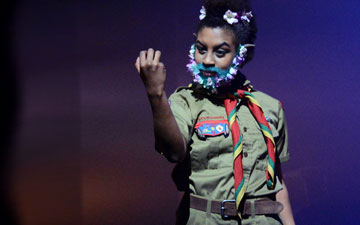
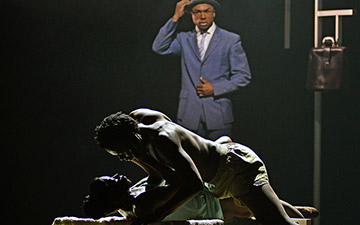
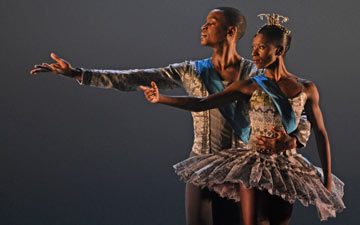

You must be logged in to post a comment.